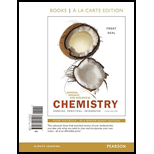
Concept explainers
a.
To match:
The
Introduction:
Nucleotides are the building blocks of the
b.
To match:
The metabolic nucleotide that matches with the description “the high-energy form of coenzyme A”.
Introduction:
Nucleotides are the building blocks of the nucleic acids such as deoxy ribonucleic acid (DNA), and ribonucleic acid (RNA). These nucleotides have significant metabolic functions in cells, therefore, called as “metabolic nucleotides”. They act as energy exchanger and can also be coenzymes. Metabolic nucleotides have two forms: a high energy form and a low energy form.
c.
To match:
The metabolic nucleotide that matches with the description “the oxidized form of nicotinamide adenine dinucleotide”
Introduction:
Nucleotides are the building blocks of the nucleic acids such as deoxy ribonucleic acid (DNA), and ribonucleic acid (RNA). These nucleotides have significant metabolic functions in cells, therefore, called as “metabolic nucleotides”. They act as energy exchanger and can also be coenzymes. Metabolic nucleotides have two forms: a high energy form and a low energy form.
Want to see the full answer?
Check out a sample textbook solution
Chapter 12 Solutions
General, Organic, and Biological Chemistry, Books a la Carte Edition (3rd Edition)
- Which nutrient provides energy in its most concentrated form?arrow_forwardWhat is the function of the enzyme succinate dehydrogenase?arrow_forward1.In the mitochondria, enzymes attached to the membrane use the ______________ to produce a ____________ difference and thus an electrical potential. Making the transfer of _______________ possible a. pH, flow of electrons, hydrogens b. pH, electron flow, oxygen c. electron flow, pH, hydrogens d. Electron flow, pH, Oxygen 2.Which of the following sugars can be a substrate for hexokinase? a.glucose b.fructose c.mannose d.all these e.none of thosearrow_forward
- List the energy yield in ATP molecules for each of the following: FADH2→FADFADH2→FAD Glucose+6O2→6CO2+6H2OGlucose+6O2→6CO2+6H2O Glucose→2lactateGlucose→2lactate Pyruvate→lactatearrow_forwardRefer to the structure 1. The metabolic pathway is an example of a. Oxidative dealkylation b. Reduction c. Oxidative deamination d. Hydrolysis 2. This pathway is true for what kind of drugs a. Endogenous amides b. Endogenous amines c. Radical species d. Endogenous amino acidsarrow_forward
 Organic And Biological ChemistryChemistryISBN:9781305081079Author:STOKER, H. Stephen (howard Stephen)Publisher:Cengage Learning,
Organic And Biological ChemistryChemistryISBN:9781305081079Author:STOKER, H. Stephen (howard Stephen)Publisher:Cengage Learning, General, Organic, and Biological ChemistryChemistryISBN:9781285853918Author:H. Stephen StokerPublisher:Cengage Learning
General, Organic, and Biological ChemistryChemistryISBN:9781285853918Author:H. Stephen StokerPublisher:Cengage Learning Chemistry for Today: General, Organic, and Bioche...ChemistryISBN:9781305960060Author:Spencer L. Seager, Michael R. Slabaugh, Maren S. HansenPublisher:Cengage Learning
Chemistry for Today: General, Organic, and Bioche...ChemistryISBN:9781305960060Author:Spencer L. Seager, Michael R. Slabaugh, Maren S. HansenPublisher:Cengage Learning
 Introduction to General, Organic and BiochemistryChemistryISBN:9781285869759Author:Frederick A. Bettelheim, William H. Brown, Mary K. Campbell, Shawn O. Farrell, Omar TorresPublisher:Cengage Learning
Introduction to General, Organic and BiochemistryChemistryISBN:9781285869759Author:Frederick A. Bettelheim, William H. Brown, Mary K. Campbell, Shawn O. Farrell, Omar TorresPublisher:Cengage Learning




